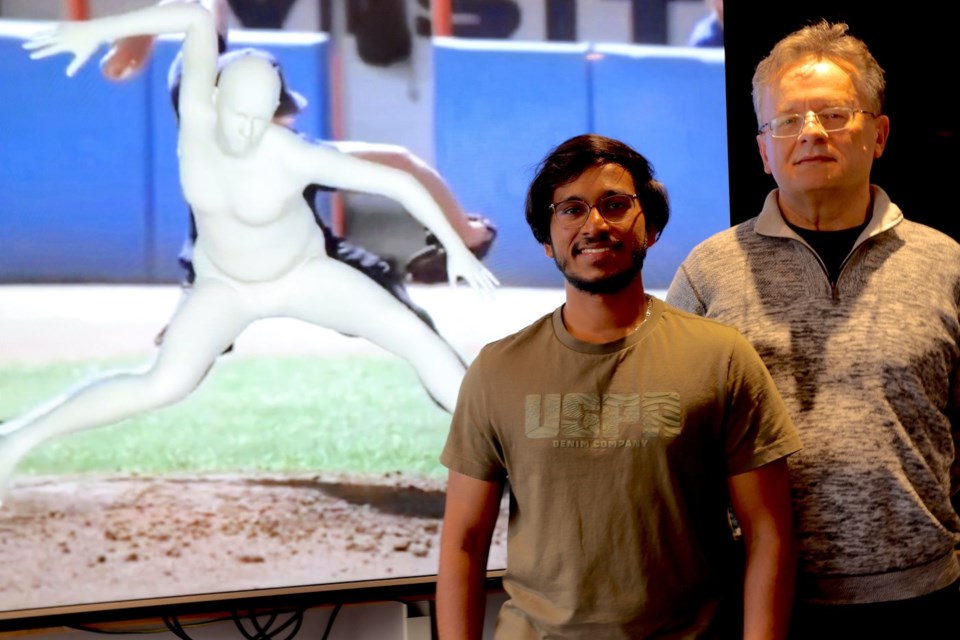Staying competitive in the American League East means staying on the cutting edge of technology.
That's why the Baltimore Orioles have partnered with researchers at the University of Waterloo to develop artificial intelligence technology, called PitcherNet, that will help the Major League Baseball team track the biomechanics of pitchers at every level of the organization, from the collegiate ranks and through its minor-league system.
PitcherNet takes the main camera feeds fans are used to seeing — either from behind the pitcher or behind the batter — and combines it with video footage shot on a smartphone by a scout or team official. Using AI, PitcherNet then extrapolates the pitcher's entire throwing motion, recreating the level of detail that the 12-camera Hawk-Eye system is capable of producing.
"What we do is we try to extract 2D information, 2D joint position information, and then extrapolate using 3D avatars," said Waterloo PhD student Jerrin Bright. "The 3D avatars are like blobs encompassing a human itself and we use those blobs to basically find the 3D human pose, which can be represented with the shape of the person, so that's the idea behind it."
Sig Mejdal, the Orioles assistant general manager, said that in his experience it's a necessity to evolve, even in a sport as old as baseball.
"It's mandatory. It's completely mandatory," said Mejdal, who worked for NASA and Lockheed Martin's satellite operations unit at Onizuka Air Force Station in Sunnyvale, Calif., before moving to the St. Louis Cardinals and then the Houston Astros. "The success that I've been a part of in St Louis, Houston and Baltimore, so much of it has come from innovation and change.
"We're the Baltimore Orioles, we're not a large market team, and we're in the American League East. We have to do everything right, and it would be foolish not to explore every avenue of improvement."
As part of that need to stay ahead of the competition, Mejdal wanted to expand the Orioles' ability to track the biomechanics of their pitchers.
Currently, every MLB ballpark and over 60 minor-league stadiums are equipped with Hawk-Eye technology, a series of cameras strategically located throughout a venue for precise 3D imaging. Primarily used by officials in tennis, soccer, and other sports for review calls, it's increasingly used in baseball to help track the throwing motion of pitchers.
This is important for two reasons. First, a successful pitcher is able to replicate the same throwing motion over and over again. Second, close analysis of a pitcher's biomechanics can help find likely causes of injuries.
But Hawk-Eye cameras are only accessible to the home team at MLB and triple-A level ballparks. Any minor-league team at a lower level or a scout at a college or high school field doesn't have access to those analytics because the expensive infrastructure is almost always unavailable.
That's where PitcherNet, a joint project between the Orioles and Bright and Waterloo professor John Zelek, comes in.
"The whole premise of the project was to replicate those capabilities from just using your smartphone by a scout sitting in the stands," said Zelek a systems design engineering professor at Waterloo and co-director of the university's Vision Image Processing lab. "So rather than the scout reporting qualitatively, now you have quantitative data from the scout at a college-level game, or wherever."
Although similar products exist, the proprietary rights to PitcherNet will be owned by the Orioles and, once it's operational, they can explore using it in more ways.
"So much of this game is using your body to generate leverage, whether you're a pitcher to throw the ball or whether you're a hitter to swing the bat," Hejdal said in a video call from his office at Oriole Park in Camden Yards. "We had to start somewhere, and the pitching seemed the obvious starting point."
This report by The Canadian Press was first published May 6, 2025.
John Chidley-Hill, The Canadian Press




